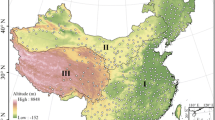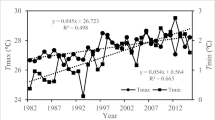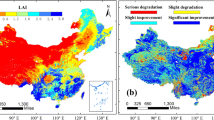Abstract
The estimation of optimum temperature of vegetation growth is very useful for a wide range of applications such as agriculture and climate change studies. Thermal conditions substantially affect vegetation growth. In this study, the normalized difference vegetation index (NDVI) and daily temperature data set from 1982 to 2006 for China were used to examine optimum temperature of vegetation growth. Based on a simple analysis of ecological amplitude and Shelford’s law of tolerance, a scientific framework for calculating the optimum temperature was constructed. The optimum temperature range and referenced optimum temperature (ROT) of terrestrial vegetation were obtained and explored over different eco-geographical regions of China. The results showed that the relationship between NDVI and air temperature was significant over almost all of China, indicating that terrestrial vegetation growth was closely related to thermal conditions. ROTs were different in various regions. The lowest ROT, about 7.0 °C, occurred in the Qinghai-Tibet Plateau, while the highest ROT, more than 22.0 °C, occurred in the middle and lower reaches of the Yangtze River and the Southern China region.








Similar content being viewed by others
References
Alcaraz-Segura D, Cabello J, Paruelo JM, Delibes M (2009) Use of descriptors of ecosystem functioning for monitoring a national park network: a remote sensing approach. Environ Manage 43(38):48
Berry J, Bjorkman O (1980) Photosynthetic response and adaptation to temperature in higher plants. Annu Rev Plant Phys 31(1):491–543
Cao MK, Prince SD, Small J, Goetz S (2004) Remotely sensed interannual variations and trends in terrestrial net primary productivity 1981–2000. Ecosystems 7:233–242
Chapin FSI (1983) Direct and indirect effects of temperature on Arctic plants. Polar Biol 2:47–52
Chen XQ, Hu B, Yu R (2005) Spatial and temporal variation of phenological growing season and climate change impacts in temperate eastern China. Global Change Biol 11:1118–1130
Cui YP, Wang RH, Liu T, Zhang HF (2010) Extraction of vegetation information in arid desert ares based on spectral mixture analysis: a case in the western Gurbantunggut desert. J Desert Res 30(2):334–341
Dong JW, Liu JY, Tao FL, Xu XL, Wang JB (2009) Spatio-temporal changes in annual accumulated temperature in China and the effects on cropping systems, 1980s to 2000. Clim Res 40(1):37–48
Dong J, Liu J, Yan H, Tao F, Kuang W (2010) Spatio-temporal pattern and rationality of land reclamation and cropland abandonment in mid-eastern Inner Mongolia of China in 1990–2005. Environ Monit Assess 179:137–153. doi:10.1007/s10661-010-1724-9
Fitter A, Fitter R (2002) Rapid changes in flowering time in British plants. Science 296(5573):1689
Fontana F, Trishchenko AP, Khlopenkov KV, Luo Y, Wunderle S (2009) Impact of orthorectification and spatial sampling on maximum NDVI composite data in mountain regions. Remote Sens Environ 113(12):2701–2712
Gu Z, Chen J, Shi P, Xu M (2005) Correlation analysis of NDVI difference series and climate variables in Xinlingole steppe from 1983 to 1999. Acta Ecologica Sinica 29(5):753–765
Häninnen H (1994) Effects of climatic change on trees from cool and temperate regions: an ecophysiological approach to modeling of budburst phenology. Can J Bot 73:183–199
Hunt ER, Kelly RD, Smith WK, Fahnestock JT, Welker JM, Reiners WA (2004) Estimation of carbon sequestration by combining remote sensing and net ecosystem exchange data for northern mixed-grass prairie and sagebrush-steppe ecosystems. Environ Manage 33:432–441
Hutchinson M (1989) New objective method for spatial interpolation of meteorological variables from irregular networks applied to the estimation of monthly mean solar radiation, temperature, precipitation and windrun. Techn Memo 89(5):95–104
Jobbágy EG, Sala OE, Paruelo JM (2002) Patterns and controls of primary production in the Patagonian steppe: a remote sensing approach. Ecology 83(2):307–319
Jönsson P, Eklundh L (2004) TIMESAT–a program for analyzing time-series of satellite sensor data. Comput Geosci 30(8):833–845
Julien Y, Sobrino JA (2009) Global land surface phenology trends form GIMMS database. Int J Remote Sens 30(13):3495–3513
Lacaze R, Balsamob G, Baretc F, Bradleyd A, et al (2009) Geoland2-Towards an operational GMES land monitoring core service. First results of the biogeophysical parameter core mapping service. http://www.isprs.org/proceedings/XXXVIII/part7/b/pdf/354_XXXVIII-part7B.pdf
Li B (2000) Ecology. Higher Education Press, Beijing
Li L, Lu H, Campbell D, Ren H (2011) Methods for estimating the uncertainty in energy table-form models. Ecol Model 222:2615–2622
Liu M (2008) Study on estimation and uncertainty of terrestrial ecosystem productivity based on RS and GIS—take the grassland transect in Tibetan Plateau for example. Nanjing Normal University, Nanjing
Liu JY, Zhang ZX, Luo D, Xiao X (2003) Land-cover classification of China: integrated analysis of AVHRR imagery and geophysical data. Int J Remote Sens 24(12):2485–2500
Liu J, Liu M, Tian H, Zhuang D, Zhang Z, Zhang W, Tang X, Deng X (2005) Spatial and temporal patterns of China’s cropland during 1990–2000: an analysis based on Landsat TM data. Remote Sens Environ 98(4):442–456
Los SO, O JC, Tucker CJ (1994) A global 11 by 11 NDVI data set for climate studies derived from the GIMMS continental NDVI data. Int J Remote Sens 15:3493–3518
Myneni RB, Keeling CD, Tucker CJ et al (1997) Increased plant growth in the northern high latitudes from 1981 to 1991. Nature 386:698–702
Nagai S, Nasahara KN, Muraoka H, Akiyama T, Tsuchida S (2010) Field experiments to test the use of the normalized-difference vegetation index for phenology detection. Agric Forest Meteorol 150(2):152–160
Pianka E (1978) Evolutionary ecology. Harper and Row, New York
Piao SL, Fang JY, Zhou LM et al (2006) Variations in satellite-derived phenology in China’s temperate vegetation. Global Change Biol 12(4):672–685
Rea R, Eccel E (2006) Phenological models for blooming of apple in a mountainous region. Int J Biometeorol 51:1–16
Schwartz MD, Chen XQ (2002) Examining the onset of spring in China. Clim Res 12:157–164
Scott D (1970) Relative growth rates under controlled temperatures of some New Zealand indigenous and introduced grasses. N Z J Bot 8:76–81
Tucker CJ, Slayback DA, Pinzon JE et al (2001) Higher northern latitude normalized difference vegetation index and growing season trends from 1982 to 1999. Int J Biometeorol 45:184–190
Wang Q, Ni J, Tenhunen J (2005) Application of geographically-weighted regression analysis to estimate net primary production of Chinese forest ecosystem. Global Ecol Biogeogr 14:379–393
White MA, Thornton PE, Running SW (1997) A continental phenology model for monitoring vegetation responses to interannual climatic variability. Global Biogeochem Cycles 11(2):217–234
Xu H, Li Y (2006) Water-use strategy of three central Asian desert shrubs and their responses to rain pulse events. Plant Soil 285(1):5–17
Zhang LY, Chen CD (2002) On the general characteristics of plant diversity of Gurbantunggut sandy Desert. Acta Ecologica Sinica 22(11):1923–1932
Zhang X, Friedl MA, Schaaf CB, Strahler AH (2004) Climate controls on vegetation phenological patterns in northern mid-and high latitudes inferred from MODIS data. Global Change Biol 10(7):1133–1145
Zheng D, Li BY (2005) Chinese eco-geographic map. Beijing Commercial Press, Beijing
Zhou L, Kaufmann RK, Tian Y et al (2003) Relation between interannual variations in satellite measures of vegetation greenness and climate between 1982 and 1999. J Geophys Res 108(D1):4004. doi:10.1029/2002JD002510
Zhu W (2005) Estimation of net primary productivity of Chinese terrestrial vegetation based on remote sensing and its relationship with global climate change. Beijing Normal University, Beijing
Zhu WQ, Tian HQ, Xu XF, Pan YZ, Chen GS, Lin WP (2011) Extension of the growing season due to delayed autumn over mid and high latitudes in North America during 1982–2006. Global Ecol Biogeogr 21(2):260–271
Acknowledgements
This study was supported by the National Basic Research Program (2010CB950901 and 2012CB955800), National Natural Science Foundation of China (41171438), and Major Program of Humanities and Social Sciences Key Research Base of Ministry of Education of China (10JJDZONGHE015).
Author information
Authors and Affiliations
Corresponding author
Rights and permissions
About this article
Cite this article
Cui, Y. Preliminary Estimation of the Realistic Optimum Temperature for Vegetation Growth in China. Environmental Management 52, 151–162 (2013). https://doi.org/10.1007/s00267-013-0065-1
Received:
Accepted:
Published:
Issue Date:
DOI: https://doi.org/10.1007/s00267-013-0065-1




